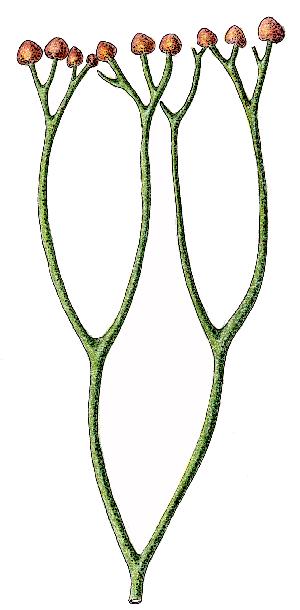When I say every species has a totem, I mean it! This includes the species that have long since ceased to exist on this physical plane. They often have a different view on this world and our concerns because they no longer have physical counterparts here, but I find them fascinating to work with.
One of my favorite plant totems in this regard is the totem of the ancient species we know as Cooksonia caledonica*. This plant and the rest of its genus (at least the species we’re aware of) is the oldest plant known to have the beginnings of a vascular system. This makes it a bridge between the bryophytes like mosses and liverworts, and more advanced vascular plants like the various flowering plants, trees, and so forth. It’s also one of the earliest land plants, and the vascular tissue in its stem was an important evolutionary step that helped plants further colonize dry land.
My relationship with Cooksonia is one of shared curiosity. Most of our interactions involve us sitting back and observing the world today, with its diversity of plant life, and being astonished at how far the plant kingdom has come in the past 400 million or so years. Cooksonia really had no idea at the time how far that one little adaptation would go, and the fact that we have redwoods and sequoias that built on the same basic system that Cooksonia evolved delights this good-natured totem. It also doesn’t seem particularly bitter about the extinction of its species; part of this is due to the great amount of time since the extinction, but it’s also that Cooksonia sees a bit of its children in their descendants today.
More than most totems, Cooksonia enjoys interacting with modern physical plants and their totems. You know how grandparents and great-grandparents admire and dote on their (great) grandchildren? it’s much like that, only with many, many more generations involved. All the Cooksonia totems have a tendency to cluster together like the old “aunties” of the family. I talk about the totem Cooksonia Caledonica in singular here, but very often it’s just the most outspoken of the group who join me in watching the world go by for a while–Cooksonia Pertoni, Cooksonia Banksii,** and the rest. They love going hiking with me and sometimes they’ll spend a great deal of time convincing me to stop and look at this particular leaf, or the shape of that trunk there.
Really, if there’s any totem that embodies my sense of awe and wonder at the world, it’s Cooksonia. I certainly haven’t had the long view on things that any of the plants have, but I can borrow their perspective for a while, and Cooksonia Caledonica is more than happy to share.
* Due to some physical structures, some scientists have assigned this plant a new genus, making it Aberlemnia caledonica instead. The totem seems to like its older name better, so I generally stick to that in working with it, but I thought it was important for readers to know the different opinions on the nomenclature for this species.
** For those not familiar with my personal formatting conventions: when talking about a physical species, I use the proper scientific nomenclature in italics and the species name starting with a lowercase letter (Cooksonia caledonica); when talking about the totem, I treat it like a proper name without italics and both the genus and species names beginning with a capital letter (Cooksonia Caledonica).
If you liked this post, please consider (pre)ordering a copy of my book, Plant and Fungus Totems: Connect with Spirits of Field, Forest and Garden, due out May 2014 from Llewellyn Worldwide. Your support is greatly appreciated!

